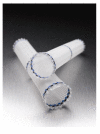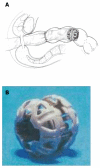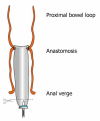Can intraluminal devices prevent or reduce colorectal anastomotic leakage: a review
- PMID: 22110276
- PMCID: PMC3218136
- DOI: 10.3748/wjg.v17.i40.4461
Can intraluminal devices prevent or reduce colorectal anastomotic leakage: a review
Abstract
Colorectal anastomotic leakage is a serious complication of colorectal surgery, leading to high morbidity and mortality rates. In recent decades, many strategies aimed at lowering the incidence of anastomotic leakage have been examined. The focus of this review will be on mechanical aids protecting the colonic anastomosis against leakage. A literature search was performed using MEDLINE, EMBASE, and The Cochrane Collaborative library for all papers related to prevention of anastomotic leakage by placement of a device in the colon. Devices were categorised as decompression devices, intracolonic devices, and biodegradable devices. A decompression device functions by keeping the anal sphincter open, thereby lowering the intraluminal pressure and lowering the pressure on the anastomosis. Intracolonic devices do not prevent the formation of dehiscence. However, they prevent the faecal load from contacting the anastomotic site, thereby preventing leakage of faeces into the peritoneal cavity. Many attempts have been made to find a device that decreases the incidence of AL; however, to date, none of the devices have been widely accepted.
Keywords: Anastomotic leakage; Colorectal surgery; Complication; Device; Rectum.
Figures






Similar articles
-
The C-seal: a biofragmentable drain protecting the stapled colorectal anastomosis from leakage.J Vis Exp. 2010 Nov 4;(45):2223. doi: 10.3791/2223. J Vis Exp. 2010. PMID: 21085104 Free PMC article.
-
Intraluminal bypass devices as an alternative to protective ostomy for prevention of colorectal anastomotic leakage: a systematic review of the literature.Colorectal Dis. 2020 Nov;22(11):1496-1505. doi: 10.1111/codi.15055. Epub 2020 Apr 25. Colorectal Dis. 2020. PMID: 32268451
-
Prevention of leakage by sealing colon anastomosis: experimental study in a mouse model.J Surg Res. 2013 Oct;184(2):819-24. doi: 10.1016/j.jss.2013.04.015. Epub 2013 Apr 28. J Surg Res. 2013. PMID: 23764314
-
Predictive factors for anastomotic leakage after laparoscopic colorectal surgery.World J Gastroenterol. 2018 Jun 7;24(21):2247-2260. doi: 10.3748/wjg.v24.i21.2247. World J Gastroenterol. 2018. PMID: 29881234 Free PMC article. Review.
-
Randomized clinical trial of biodegradeable intraluminal sheath to prevent anastomotic leak after stapled colorectal anastomosis.Br J Surg. 2017 Jul;104(8):1010-1019. doi: 10.1002/bjs.10534. Epub 2017 May 10. Br J Surg. 2017. PMID: 28488729 Clinical Trial.
Cited by
-
Review of Colonic Anastomotic Leakage and Prevention Methods.J Clin Med. 2020 Dec 16;9(12):4061. doi: 10.3390/jcm9124061. J Clin Med. 2020. PMID: 33339209 Free PMC article. Review.
-
Anastomotic leakage in rectal cancer surgery: Retrospective analysis of risk factors.World J Clin Cases. 2022 Dec 26;10(36):13321-13336. doi: 10.12998/wjcc.v10.i36.13321. World J Clin Cases. 2022. PMID: 36683625 Free PMC article.
-
Application of the advance incision in robotic-assisted laparoscopic rectal anterior resection.Front Surg. 2023 Mar 7;10:1141672. doi: 10.3389/fsurg.2023.1141672. eCollection 2023. Front Surg. 2023. PMID: 36960211 Free PMC article.
-
Application of the cuff rectum drainage tube in total mesorectal excision for low rectal cancer: A retrospective case-controlled study.Medicine (Baltimore). 2019 Jun;98(23):e15939. doi: 10.1097/MD.0000000000015939. Medicine (Baltimore). 2019. PMID: 31169715 Free PMC article.
-
Impact of anal decompression on anastomotic leakage after low anterior resection for rectal cancer: a propensity score matching analysis.Langenbecks Arch Surg. 2015 Oct;400(7):791-6. doi: 10.1007/s00423-015-1336-5. Epub 2015 Aug 29. Langenbecks Arch Surg. 2015. PMID: 26318026
References
-
- Jung SH, Yu CS, Choi PW, Kim DD, Park IJ, Kim HC, Kim JC. Risk factors and oncologic impact of anastomotic leakage after rectal cancer surgery. Dis Colon Rectum. 2008;51:902–908. - PubMed
-
- Peeters KC, Tollenaar RA, Marijnen CA, Klein Kranenbarg E, Steup WH, Wiggers T, Rutten HJ, van de Velde CJ. Risk factors for anastomotic failure after total mesorectal excision of rectal cancer. Br J Surg. 2005;92:211–216. - PubMed
-
- Matthiessen P. Risk factors for anastomotic leakage after anterior resection of the rectum. Colorectal Dis. 2006;8:366. - PubMed
-
- Dehni N, Schlegel RD, Cunningham C, Guiguet M, Tiret E, Parc R. Influence of a defunctioning stoma on leakage rates after low colorectal anastomosis and colonic J pouch-anal anastomosis. Br J Surg. 1998;85:1114–1117. - PubMed
-
- Laxamana A, Solomon MJ, Cohen Z, Feinberg SM, Stern HS, McLeod RS. Long-term results of anterior resection using the double-stapling technique. Dis Colon Rectum. 1995;38:1246–1250. - PubMed
Publication types
MeSH terms
LinkOut - more resources
Full Text Sources
Other Literature Sources
Medical

